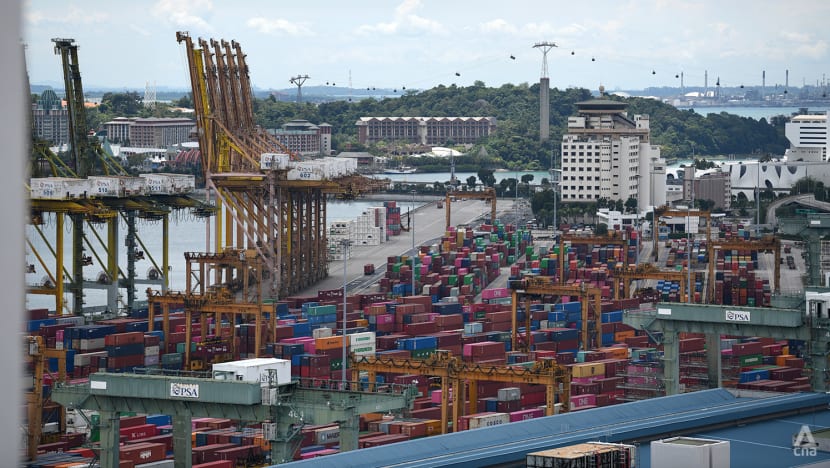Container shipping industry starts to come down from pandemic highs
Even the typically busy August to October period – when businesses move goods for the year-end retail season – appears to have weakened.

Container cranes and shipping containers seen at the PSA Tanjong Pagar Terminal. (File photo: CNA/Calvin Oh)
SINGAPORE: One of the biggest players in the container shipping industry, Maersk, recently lifted its annual profit forecasts for the third time this year.
It raised its full-year forecast for underlying operating profits from US$24 billion to about US$31 billion.
Independent maritime research consultancy Drewry estimates that the entire industry will make an operating profit of US$270 billion this year, more than 10 times the profit of US$26 billion in 2020.
Boosted by soaring demand for masks and other personal protective equipment, along with consumer spending during the COVID-19 pandemic, the industry has enjoyed a boom over the past two years.
But the effect of the pandemic appears to be wearing off and the industry is expected to be coming down from its highs.
Even the typically busy August to October period – when businesses move goods for the year-end retail season – appears to have weakened.
MODERATE PEAK SEASON
The industry is expecting a more moderate peak season depending in part on how China’s zero-COVID policy plays out and how the energy crisis evolves, said DHL’s chief executive John Pearson.
Mr Raymon Krishnan, president of Singapore’s Logistics and Supply Chain Management Society, noted that Trans-Pacific eastbound rates have slipped below US$5,000 per container. Last year, a container cost about US$15,000 to US$20,000.
“There’re even signs that it is going to, very soon, or possibly, even reach the US$2,000 per TEU mark, which is what we used to see pre-COVID,” he told CNA.
TEU refers to Twenty Equipment Unit, which means 20-foot container.
The Drewry consultancy also said that the spot rate for the benchmark route from Asia to the US fell to slightly less than US$5,000 per 40-foot container, marking the first time the index has slipped below that level since December 2020.
But the rate is still double that of pre-pandemic levels.
SHIPPING COSTS AND INFLATION
Globally, shipping costs are a key driver of inflation. When freight rates rise, prices for goods do too, although the pass-through to inflation from such rates is less than those associated with food or fuel costs.
Mr George Griffiths, managing editor of Global Container Freight at S&P Global Commodity Insights, noted that the world is seeing a general increase in the cost of living.
He added that wages are not rising at the same pace as costs of food, housing and energy.
“This is a genuine concern for the market … (But) it's a free market, and the people who own and operate the ships are perfectly at will to charge whatever they like, whatever they see fit,” he told CNA.
For now, though, lower shipping demand and prices mean costs should come down and supply chain logjams should ease.
Maersk said a “gradual normalisation” of freight rates will likely happen in the last quarter of next year, while the Logistics and Supply Chain Management Society expects significant downward pricing to start earlier – in the first quarter of 2023.
The container shipping industry is bracing for an impending lull, but it is confident the strong earnings from the past two years can cushion some of the impact.
The industry is looking for something to replace the boom during COVID-19, and third party logistics companies and shippers are looking at sustainability as the “new big thing”, said Mr Raymon.
“Things are rationalising, things are slowing down. But it's not catastrophic. It's not bad. It's just more challenging."

















